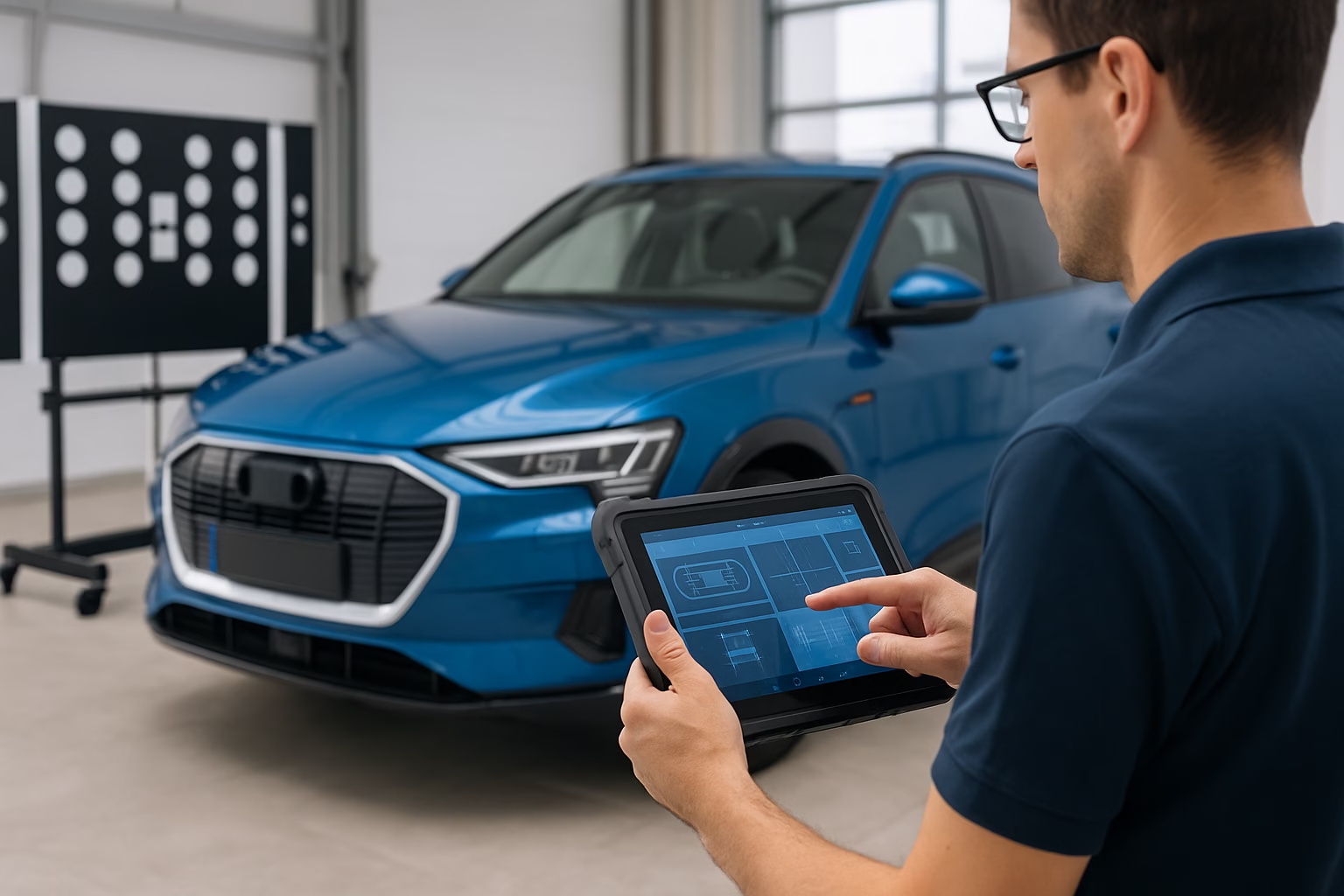Calibration is the process of teaching a vehicle’s sensors where the real world is. Camera, radar and LiDAR modules that support lane keeping, adaptive cruise control and autonomous emergency braking need to know exactly where their forward focus, yaw angle and height should be relative to the vehicle’s centreline. When a windscreen is replaced, a radar bracket is removed, or a bumper is repaired, those delicate alignments change. Calibration ensures the sensors see straight ahead and measure distance accurately. There are two broad approaches to ADAS calibration: static and dynamic. Understanding the differences, and when each method is required, is critical for technicians tasked with restoring safety systems to factory specifications.
Static calibration is performed while the vehicle is stationary. The technician positions the car on a level floor and builds an artificial world around it using targets, reflectors and scan tools. Every manufacturer has its own specification for placement distances, heights and angles. Toyota’s forward camera calibration, for example, involves setting up a printed target board at a precise height and distance from the vehicle’s centreline, verified with a plumb bob and measuring tape. The technician uses a scan tool to trigger the calibration mode; the camera then looks at the board and learns a new zero point. This process is known as “static” because the vehicle never moves. Sensors like front-facing cameras and short-range radar units rely on geometric relationships between the sensor and the vehicle’s physical structure. In a static calibration, the environment is controlled; the only variables are the target and the placement of the vehicle.
Static calibration requires space and equipment. A typical camera calibration rig includes adjustable stands, laser measuring devices, and specialized targets printed with bar codes or checkerboards. The floor must be level, and the workshop lighting must be free of glare or reflections. Each manufacturer supplies an exact procedure that cannot be guessed or approximated. Honda, for instance, specifies a target height with tolerances measured in millimetres and requires the vehicle’s fuel tank to be at least half full. Deviating from these requirements can result in sensors reading an incorrect horizon or lateral offset, which later appear as drift or false warnings during driving. The advantage of static calibration is repeatability. Once a technician has set up the rig and measured distances correctly, the calibration normally completes quickly, and there is no need to drive the vehicle on public roads. This is particularly beneficial in areas where road markings are poor or traffic is heavy.
A practical example of static calibration is the Toyota RAV4 after a windshield replacement. Toyota’s Safety Sense camera sits at the top of the windscreen. When the glass is removed, even a small shift of a few millimetres requires a new calibration. The procedure begins by performing a health check with the factory scan tool. The car is positioned on the floor with a line drawn through the vehicle’s centre. The target board is placed 4.5 metres forward and 0 mm offset, with a height of 900 mm. The scan tool triggers the calibration routine; the camera takes about five minutes to read the target. Once complete, a road test confirms that lane centring, lane departure alert and adaptive cruise functions engage without false alarms. Static calibration ensures that the camera’s internal horizon aligns with the real world.
Dynamic calibration, by contrast, uses the real world as the reference. Instead of positioning a target in a workshop, the calibration is performed while driving at set speeds on roads with clear lane markings. Many manufacturers, including Hyundai, Mazda and some Volkswagen models, use dynamic calibration for radar and camera systems. After a sensor is replaced, the technician uses a scan tool to initiate calibration, then drives the vehicle at speeds typically between 40 and 80 km/h while maintaining lane discipline. The vehicle’s control module monitors lane lines, other vehicles and stationary objects to compute offsets and adjust the sensor’s internal alignment. Calibration is complete when the scan tool indicates success; there is no need to measure distances or set up targets.
Dynamic calibration has several advantages. It requires less workshop space and equipment, making it accessible to smaller repairers. It calibrates sensors in the environment in which they operate, which can capture real-world variables such as road crown or subtle variations in lane geometry. However, dynamic calibration is dependent on external conditions. The technician must choose a road with well-defined lane markings, minimal traffic and good weather. Rain, fog or strong sun glare can prevent the sensor from seeing lane lines, causing calibration to fail. Some vehicles require the driver to maintain a steady speed for several minutes without interruptions such as braking or lane changes. If traffic is heavy or the technician cannot maintain speed, calibration must be repeated. Additionally, dynamic calibration often requires the fuel tank to be full and the vehicle loaded as specified to avoid calibration offsets.
Consider a Hyundai Santa Fe after replacing a front radar unit. Hyundai’s procedure calls for a dynamic calibration at 60–80 km/h. After connecting the scan tool and selecting the calibration routine, the technician drives on a straight road with clear lane markings. The radar module monitors other vehicles and roadside objects to align its internal beam angle and range. The scan tool displays progress in percentage. If the driver brakes suddenly or changes lanes abruptly, the process resets. When calibration completes, the tool confirms success, and the adaptive cruise control is tested for correct following distance and smooth deceleration. This dynamic process cannot be performed inside a workshop; it depends on a good road.
In practice, many vehicles require both static and dynamic calibration. Modern systems combine cameras, radar and sometimes LiDAR. For example, a Volkswagen Golf with a multi-functional camera and radar may require a static calibration of the camera using a target board, followed by a dynamic calibration of the radar module during a road test. The static portion establishes the camera’s geometric relationship with the windscreen; the dynamic portion allows the radar to learn real-world road conditions and refine its internal alignment. Failing to complete either step can lead to false lane departure warnings or improper adaptive cruise control distances.
The choice between static and dynamic calibration is not an option for the technician—it is dictated by the manufacturer. Each service manual specifies whether a static target board, a dynamic road test, or a combination is required after certain repairs. Technicians need to invest in appropriate equipment and training. A static calibration rig can be expensive, but it allows you to service brands that require static calibration. Meanwhile, knowledge of dynamic calibration procedures is essential to handle vehicles that need road tests. It is also important to keep the workshop environment clean, level and well-lit to ensure accurate static calibrations.
When performing static or dynamic calibration, documentation is critical. Before starting, record the vehicle’s condition, including wheel alignment, tyre pressure, ride height and any modifications. During static calibration, note the target distances, heights and tool models used. During dynamic calibration, record the weather conditions, road type, speed range and any difficulties encountered. After calibration, perform a verification test on the road to confirm that lane keeping and adaptive cruise control engage correctly without warnings. Keep this documentation for both quality control and liability purposes.
In summary, static calibration uses artificial targets to define the sensor’s view in a controlled environment, while dynamic calibration uses real-world road conditions. Static calibration provides repeatable results and is essential for camera modules that rely on geometric alignment. Dynamic calibration is simpler in terms of equipment but is vulnerable to environmental factors. Many vehicles require a hybrid approach combining both methods. Understanding when and how to perform each type of calibration, investing in the right tools and training, and following OEM procedures are essential for any workshop servicing advanced driver assistance systems.

Hiran Alwis is an automotive lecturer and ADAS specialist with over 15 years of experience in diagnostics, advanced safety systems, and technical training. He founded ADAS Project to help everyday drivers and workshop technicians understand and safely use advanced driver assistance systems.
